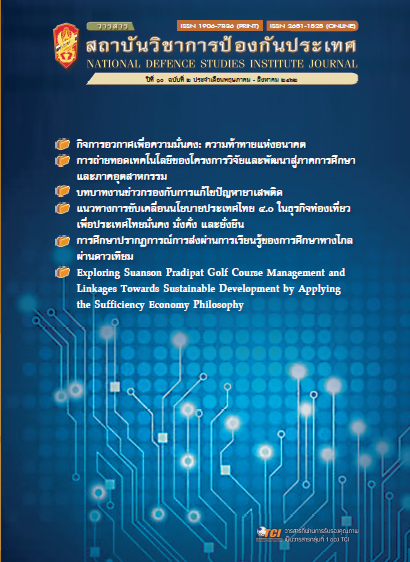The Way to Build Stability Prosperity and Sustainability for Driving Thailand's 4.0 Policies in Tourism Business
Main Article Content
Abstract
This research is a huge project consisting of 6 sub-research projects classified according to
tourism areas which aim to propose the way to build stability prosperity and sustainability for driving
Thailand's 4.0 policies in the tourism business. Also, this research is a qualitative method that
collected data by in-depth interviewing with focus group using semi-structured interview
prepared for entrepreneurs. The content validity of the questionnaire was reviewed by 5 professional
tourism businesses using an index of concordance (IOC). The focus group person could be classified
into 6 areas where the researchers are interested to be used as the study areas. These areas are
as follows: 1. Historical tourism study area at a Japanese village and Portuguese village in
Ayutthaya province, 2. Agro-tourism studies area at Rayong and Chantaburi provinces. The general
context of agro-tourism at Rayong and Chantaburi provinces, 3. Nature based & recreational tourism
study area is at Nong-Pla-Lai community, Nong- Pla-Lai sub-district, Bang-La-Moong district,
Chonburi province, 4. The eco-tourism study area is a community group in Bang Kachao, Samut Prakan
province, 5. The cultural tourism area is at Baan Tawai community, Chiangmai province, and 6. Health
tourism study area is at Thai Traditional Medical School, Wat Phra Chetuphon Vimolmangklararm
Rajwaramahaviharn (Wat Pho), Bangkok. Organizational management theories including McKinsey
7-S Framework and PEST are applied in this research in order to analyze the external factors
and internal factors. A perspective of tourism business organization is analyzed by SWOT
analysis. This is to recommend the guidelines for the implementation of Thailand 4.0 policy, to
possess the stability, prosperity and sustainability in the tourism business, where it can be synthesized by TOWS Matrix Model in order to manage the tourism. This research studied
between April to August 2018.
This recommendation can further lead to the proposal of tourism business development in all 6 tourism areas. The Guideline for creating the stability tourism is that: the product should have the quality control which creating values for the responsibility of products and services, also that by-product from doing this activity should considering the effect to natural and environmental preservation, continuous systematic-development and creating the confidence of tourists. Guideline for creating prosperity is that: topping up the knowledge received from the business like by using neon light to stimulate the product growth, doing the organic farm, applying the agricultural field standard maintenance method, pushing
forward Thailand agro-tourism to be worldwide known, encouraging more systematically online
product business, bringing the renewable energy technology such as solar cell and wind power
to be applied in agricultural field to reduce the cost and save the environment, encouraging the
processed agricultural product, developing the local packaging form to make it more value added,
and support for off-season product sales. Finally, guideline for creating sustainability is that:
business should apply the sufficient economy theory which will be a happy living in that
business community. Also using natural resources with a cost-effective of waste management
and expand the knowledge and skills related to the community and use of renewable energy
technologies. Final, According to Thailand 4.0 policy, this research proposes the three ways
to transform Thailand which areas the stability, prosperity and sustainability contexts, the related
persons are community organizations that operate tourism, government agencies involved, interested
parties they can apply these three ways to the development of tourism to achieve excellence.
Article Details
The articles, images, tables, graphs, written content, and opinions published in this journal are solely those of the authors and do not necessarily reflect the views or positions of the National Defence Studies Institute or its academic affiliates.
References
กรมการท่องเที่ยว กระทรวงการท่องเที่ยวและกีฬา. (๒๕๕๗). แผนยุทธศาสตร์และกลยุทธ์พัฒนาการท่องเที่ยว กรมการท่องเที่ยว ปี
พ.ศ.๒๕๕๗-๒๕๖๐.
กองบริหารงานวิจัยและประกันคุณภาพการศึกษา สถาบันส่งเสริมการจัดการความรู้เพื่อสังคม, มหาวิทยาลัยพะเยา. (๒๕๖๐).
Thailand 4.0 โมเดลขับเคลื่อนประเทศไทยสู่ความมั่นคง มั่งคั่ง และยั่งยืน./(พิมพ์เขียว).
ยุทธศักดิ์ สุภสร. (๒๕๖๑). กระทรวงการท่องเที่ยวและกีฬา. กระทรวงการท่องเที่ยวฯ เร่งเครื่องนโยบาย ๔.๐ จับมือ ๙ พันธมิตร เชื่อม
โยงข้อมูลด้านท่องเที่ยวเพื่อความเป็นเลิศ. สืบค้นเมื่อ ๒๙ เมษายน ๒๕๖๑, จาก https://www.mots.go.th/.
สำนักเลขาธิการนายกรัฐมนตรี. (๒๕๖๐). กรอบยุทธศาสตร์ชาติในระยะ ๒๐ ปี (พ.ศ.๒๕๖๐-๒๕๗๙). สืบค้นเมื่อ ๒๙ เมษายน
๒๕๖๑, จาก https://www.egov.go.th/.
Robert H. Waterman, Thomas J. Peters, Julien R. Phillips. (1980). The games players: by John Brooks. New York:
Times Books.
The Travel & Tourism Competitiveness Report 2015. World Economic Forum (WEF), from: https://
www.weforum.org/


